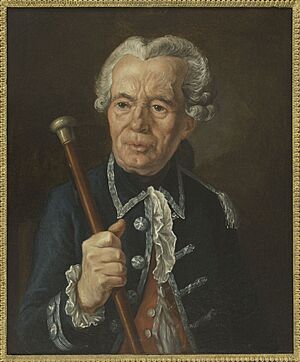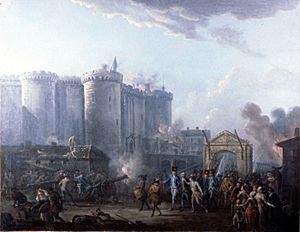Bernard-René Jourdan de Launay facts for kids
Quick facts for kids
Bernard-René Jourdan de Launay
|
|
|---|---|
| Marquis of Launay | |
 |
|
| Born | Bernard-René Jourdan 8/9 April 1740 The Bastille, Paris, France |
| Died | 14 July 1789 (aged 49) Place de Greve, Paris, France |
| Spouse(s) | Ursule Philippe Geneviève Thérèse Le Boursier |
| Issue |
|
| Father | René Jourdan de Launay |
| Mother | Charlotte Renée Aubry d'Armanville |
| Governor of the Bastille | |
| In post October 1776 – 14 July 1789 |
|
| Preceded by | Antoine-Joseph de Jumilhac |
| Succeeded by | Position abolished during French Revolution
|
Bernard René Jourdan, Marquis de Launay (born April 8 or 9, 1740 – died July 14, 1789) was a French governor of the Bastille. He was the son of a previous governor. He was in charge of the Bastille's soldiers when the famous prison-fortress in Paris was attacked on July 14, 1789. This event, known as the Storming of the Bastille, was a major moment in the French Revolution.
Early Life and Career
Bernard-René Jourdan de Launay was born in the Bastille itself, where his father was the governor. When he was eight years old, he got an honorary job with the King's Musketeers (mousquetaires du roi). Later, he joined the French Guards (gardes-françaises), a group of soldiers stationed in Paris.
In 1776, de Launay became the Governor of the Bastille, taking over from M. de Jumilhac. Back then, it was common for people to buy important jobs like this as a way to invest their money.
His time as governor was mostly quiet. However, in 1778, he made a mistake by not firing the Bastille's cannon to celebrate the birth of a daughter to King Louis XVI. In 1785, he was in charge of keeping two important people, Cardinal Louis de Rohan and Jeanne de La Motte-Valois, in prison. They were involved in a big royal scandal about a diamond necklace. De Launay treated them fairly, even though one of the prisoners was very difficult.
He also owned land in Normandy and rented out houses near the Bastille.
The Storming of the Bastille

On July 14, 1789, the Bastille's usual group of soldiers, called invalides (veteran soldiers), was about 82 men. Two days before the attack, 32 Swiss soldiers joined them to help defend the fortress.
Earlier that day, another governor had given in to the demands of the revolutionaries. But de Launay refused to surrender the Bastille or hand over the weapons and gunpowder stored inside. He promised not to shoot unless attacked and tried to talk with two representatives from the city. However, the talks took too long. An impatient crowd began to enter the outer courtyard after breaking the chains of a drawbridge.
After shouting warnings, the soldiers inside the Bastille opened fire. The attackers thought this was a trick by de Launay. The fight lasted about four hours. Around 100 attackers were hurt or killed, but only a few defenders were injured because they were well-protected inside the fortress.
With no water and little food, de Launay decided to give up. He said he would surrender only if no one inside the Bastille was harmed. He even threatened to blow up the entire fortress and the surrounding area if his conditions were not met. His conditions were rejected, but he surrendered anyway. This happened after some of his own soldiers stopped him from going to the cellars where the gunpowder was kept. Around 5 p.m., the firing stopped, and the drawbridge was suddenly lowered.
De Launay was immediately captured. His sword and special staff were taken from him. He was supposed to be taken to the Hôtel de Ville (City Hall) by a leader of the attack, Pierre-Augustin Hulin. However, on the way, an angry crowd attacked the governor and eventually killed him. He was killed near the Hôtel de Ville.
Three other officers and two veteran soldiers from the Bastille were also killed by the crowd. Most of the other defenders were protected by the French Guards, who had joined the attackers, and were later set free.
What People Thought of Him
The historian Simon Schama described de Launay as a "reasonably conscientious" official who treated prisoners better than previous governors. Even the Marquis de Sade, a famous writer who had been a prisoner in the Bastille, said that de Launay was a "so-called marquis whose grandfather was a servant."
Lieutenant Deflue, the officer in charge of the Swiss soldiers who helped de Launay, later said that his former commander was not good at military decisions and was unsure of himself. However, de Launay was in a very difficult situation because the royal troops around Paris did not give him enough help. Marshal de Broglie, who was in charge of the efforts to stop the unrest in 1789, had even written that he was worried about both de Launay and the soldiers at the Bastille.
See Also
 In Spanish: Bernard-René Jordan de Launay para niños
In Spanish: Bernard-René Jordan de Launay para niños


